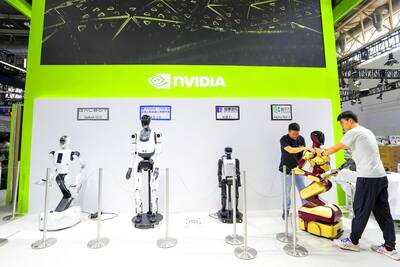Phison Electronics Corp (群聯電子), a designer of NAND flash memory controllers and modules, yesterday reported that revenue last quarter grew 11 percent from a year earlier on the back of new orders from Japan’s largest pachinko maker.
Revenue last quarter expanded to NT$10.86 billion (US$366.82 million) from NT$9.79 billion a year earlier, Phison said.
However, on a quarterly basis, revenue slumped 15.62 percent from NT$12.87 billion, it said.
The Miaoli-based company said that it is benefiting from growing demand for solid-state drives (SSDs) used in devices beyond computers, which is stimulating growth for the NAND flash memory industry.
Pachinko machines are one of the new growth areas, it said.
“Pachinko makers started equipping their machines with NAND storage products, such as SSDs, in recent years to cope with higher-resolution animations used on the machines,” Phison chairman Pua Khein-seng (潘健成) said in a statement.
“Phison last year received orders from Japan’s largest pachinko brand and began shipments this year. The orders will have a positive effect on Phison’s revenue and profit,” Pua said.
Phison’s shipments of chip controllers used in SSDs and embedded multimedia cards last month surged 50 percent year-on-year, bringing its overall shipments of chip controllers used in those two devices to a historical high last quarter, it said.
Separately yesterday, Winbond Electronics Corp (華邦電子) said its revenue rose 0.87 percent to NT$4.13 billion last month from NT$4.09 billion a year earlier.
Revenue last quarter grew about 6 percent annually and 10.39 percent quarterly to NT$12.75 billion, it said.
Local peer Macronix International Co (旺宏電子) also reported a 24 percent annual increase in revenue to NT$9.28 billion for last quarter.
However, the figure represented a 1.49 percent quarterly decline.
Meanwhile, market researcher TrendForce Corp (集邦科技) said that the COVID-19 pandemic has curtailed demand for smartphones, which might lead to less consumption of DRAM and NAND flash memory chips.
As demand shrinks, DRAM chip prices are to slump 10 to 15 percent this year, while NAND flash memory chip prices are to be flat from last year, TrendForce said.
“Most of our attention is drawn to the smartphone [segment], which is to see shipments drop 11.3 percent this year. Smartphones consume about 40 percent of DRAM and NAND flash products produced,” TrendForce analyst Avril Wu (吳雅婷) told an online forum in Taipei.
Before the pandemic started to weigh on consumer demand, TrendForce had forecast that smartphone shipments would slide 3.5 percent annually this year.

UNCERTAINTIES: Exports surged 34.1% and private investment grew 7.03% to outpace expectations in the first half, although US tariffs could stall momentum The Chung-Hua Institution for Economic Research (CIER, 中華經濟研究院) yesterday raised its GDP growth forecast to 3.05 percent this year on a robust first-half performance, but warned that US tariff threats and external uncertainty could stall momentum in the second half of the year. “The first half proved exceptionally strong, allowing room for optimism,” CIER president Lien Hsien-ming (連賢明) said. “But the growth momentum may slow moving forward due to US tariffs.” The tariff threat poses definite downside risks, although the scale of the impact remains unclear given the unpredictability of US President Donald Trump’s policies, Lien said. Despite the headwinds, Taiwan is likely

When Lika Megreladze was a child, life in her native western Georgian region of Guria revolved around tea. Her mother worked for decades as a scientist at the Soviet Union’s Institute of Tea and Subtropical Crops in the village of Anaseuli, Georgia, perfecting cultivation methods for a Georgian tea industry that supplied the bulk of the vast communist state’s brews. “When I was a child, this was only my mum’s workplace. Only later I realized that it was something big,” she said. Now, the institute lies abandoned. Yellowed papers are strewn around its decaying corridors, and a statue of Soviet founder Vladimir Lenin

UNIFYING OPPOSITION: Numerous companies have registered complaints over the potential levies, bringing together rival automakers in voicing their reservations US President Donald Trump is readying plans for industry-specific tariffs to kick in alongside his country-by-country duties in two weeks, ramping up his push to reshape the US’ standing in the global trading system by penalizing purchases from abroad. Administration officials could release details of Trump’s planned 50 percent duty on copper in the days before they are set to take effect on Friday next week, a person familiar with the matter said. That is the same date Trump’s “reciprocal” levies on products from more than 100 nations are slated to begin. Trump on Tuesday said that he is likely to impose tariffs

READY TO BUY: Shortly after Nvidia announced the approval, Chinese firms scrambled to order the H20 GPUs, which the company must send to the US government for approval Nvidia Corp chief executive officer Jensen Huang (黃仁勳) late on Monday said the technology giant has won approval from US President Donald Trump’s administration to sell its advanced H20 graphics processing units (GPUs) used to develop artificial intelligence (AI) to China. The news came in a company blog post late on Monday and Huang also spoke about the coup on China’s state-run China Global Television Network in remarks shown on X. “The US government has assured Nvidia that licenses will be granted, and Nvidia hopes to start deliveries soon,” the post said. “Today, I’m announcing that the US government has approved for us